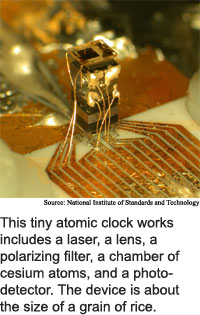
Atomic clock to sync handhelds
By Eric Smalley, Technology
Research NewsAtomic clocks keep extremely accurate time by measuring the vibration of atoms. They have been around for 50-odd years, but they aren't in widespread commercial use because they tend to be large and draw a lot of power.
Researchers from the National Institute of Standards and Technology (NIST) have devised the principal component of an extremely tiny atomic clock that will draw very little power.
The physics package, or atomic works, of the clock is 9.5 cubic millimeters, or about the size of a grain of rice, and keeps time accurately enough that it is likely to be off by no more than 25 microseconds per day, which translates to no more than a second per 126 years, said Leo Hollberg, a group leader in the Time and Frequency Division at the National Institute of Standards and Technology (NIST).
The atomic works can be fabricated on standard computer chips using existing manufacturing methods for making microelectromechanical systems. This makes it potentially easy to mass produce and integrate with other electronics.
The chip-scale atomic clock consumes 73 thousandths of a watt, which is comparable to common quartz crystal oscillators. The device is the key step toward integrating battery-operated atomic clocks into handheld devices like Global Positioning System (GPS) systems, radios and cellphones.
"Until now, atomic clocks were too big and required too much power to even be considered for battery-powered instruments," said Hollberg. "One application that seems likely in the near future is in GPS receivers, where precise timing can enhance the performance... [and] reduce vulnerability to jamming," he said.
The smallest previously developed atomic works is about one cubic centimeter in size and uses several watts of power, according to Hollberg.
Precise timing in a small package also promises to improve secure communications protocols and support higher data transfer rates, said Hollberg. "As data rates increase, better timing resolution and synchronization are required," he said.
The researchers' atomic works consist of a cesium vapor cell, a semiconductor laser, a photodetector, a lens, and filters.
The device measures the vibration frequency of cesium atoms, which is 9,192,631,770 cycles per second, and uses the measurement to calibrate a quartz crystal electronic oscillator.
To take the cesium frequency measurement, the clock's laser excites cesium atoms to the appropriate energy state for resonating with a microwave field. A microwave field, tuned by an electronic oscillator, cycles through a narrow range of frequencies close to the cesium atom's resonant frequency. As the microwaves resonate with the cesium atoms, the atoms fluoresce, or release energy in the form of photons, which are detected by the device's photodetector. When the microwave field is tuned to the atoms' precise resonant frequency, the atoms reach their maximum fluorescence level.
The measurement of the peak fluorescence calibrates the oscillator, and this feedback loop locks the microwave field to the resonant frequency.
The researchers are working on making the clock accurate to one microsecond per day, or one second in 3,171 years, dropping its power consumption to 30 milliwatts, and putting it in a package that, including an oscillator and control electronics, would measure one cubic centimeter, said Hollberg. "Compared to the smallest commercial atomic clocks this would be a volume reduction by a factor of about 50 times, and a reduction in power consumption by about 100 times," he said.
Such a clock would be about 1,000 times more accurate than the high quality quartz crystal oscillators used in many types of instruments today, said Hollberg.
NIST's most accurate atomic clock, NIST-F1, takes more than 30 million years to gain or lose a second. The device, which is the primary clock for official U.S. time, occupies most of a room.
It will be about five years before the chip-scale atomic clock is ready for commercialization, Hollberg said.
Hollberg's research colleagues were Svenja Knappe, John Kitching, Li-Anne Liew and John Moreland from the National Institute of Standards and Technology, and Vishal Shah and Peter D. D. Schwindt from the National Institute of Standards and Technology and the University of Colorado at Boulder. The work appeared in the August 30, 2004 issue of Applied Physics Letters. The research was funded by the Defense Advanced Research Projects Agency (DARPA) and the National Institute of Standards and Technology.
Timeline: 5 years
Funding: Government
TRN Categories: Applied Technology; Physics
Story Type: News
Related Elements: Technical paper, "A Microfabricated Atomic Clock," Applied Physics Letters, August 30, 2004
Advertisements:
October 6/13, 2004
Page One
Atomic clock to sync handhelds
Quantum math models speech
Page layout drives Web search
Fluid chip does binary logic
Briefs:
Chip spots DNA electrochemically
Crystal structure tunes nanowires
Gas flow makes electricity
Sound makes electricity for space
Design rules build on self-assembly
Nanotube diode reverses itself

News:
Research News Roundup
Research Watch blog
Features:
View from the High Ground Q&A
How It Works
RSS Feeds:
News
Ad links:
Buy an ad link
| Advertisements:
|
 |
|
TRN
Newswire and Headline Feeds for Web sites
|
© Copyright Technology Research News, LLC 2000-2011. All rights reserved.